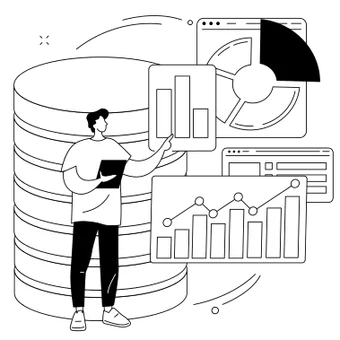Marketing ETL for your modern data stack

Marketing ETL tools are popular because marketers deal with many data sources that need to be visualized, analyzed, and distributed to stakeholders and clients.
In this article, we’ll define what ETL tools are, why they are helpful for marketers, and how to get started with an ETL tool in 2023.
Table of content
- What does marketing ETL mean?
- Differences Between ETL vs. ELT
- What are ETL tools?
- Why ETL tools are important for marketers
- What are the criteria for choosing ETL tools?
- 10 Best ETL tools for collecting marketing data
- How to get started with an ETL tool
- What are the advantages and disadvantages of using an ETL
- Wrapping it up
- FAQ
What does marketing ETL mean?
ETL stands for Extract, Transform, Load. It’s a process commonly used in data warehousing and business intelligence to collect, clean, and consolidate data from different sources for analysis and reporting.
The ability of a reliable ETL tool to extract information from various sources, standardize it into a unified format, and load it into a target system like a data warehouse or data lake is crucial for enabling effective data analysis and decision-making.
This information emphasizes how ETL tools serve as a bridge between diverse data sources and data analytics applications, making it easier for business users to leverage data for insights and performance measurement.
ETL Process
This breakdown makes it clear how ETL works step by step:
- Extract raw data: This is the first step where the ETL platform gathers data from various sources simultaneously. The examples provided, such as survey results, email response rates, and sales data, demonstrate the diversity of sources that ETL can handle.
- Transform data for analysis: This step involves preparing the data for analysis. It includes tasks like standardizing formats and checking for data quality. The mention of removing incomplete or corrupted data highlights the importance of data integrity.
- Load data into a data destination: After the data has been cleaned and reformatted, it’s loaded into a data warehouse or another designated storage location. The choice of destination depends on how the data will be used, and the distinction between structured and unstructured data is noted.
Differences Between ETL vs. ELT
The fundamental difference lies in when the data transformation occurs. In ETL, it takes place before loading the data, while in ELT, transformation happens after the data has been loaded into the target system.
Both approaches have their strengths and are suitable for different scenarios. ETL is often preferred for complex transformations and when data needs to be standardized before loading. On the other hand, ELT is advantageous for scenarios where raw data needs to be stored first and transformations can be applied within the destination system.
What are marketing ETL tools?
ETL tools are used to extract, transform and load data from different sources in different formats. Marketing data by default is siloed, which means you have a different data set in Google Ads, Facebook Ads, Google Analytics 4 and Salesforce as they are not built on the same technologies. The different sources tend to also have different terminologies.
The more complex the technology landscape you are operating in gets, the harder it is to harmonise your data. Larger organisations will have different campaigns running in different countries with different currencies using different time-zones and naming structures. Depending on the organisation the data ownership lies with different teams and people with different KPI’s.
Depending on various factors, you can basically divide the ETL tools into the following categories:
Custom ETL tools
Batch ETL tools
Cloud ETL tools
Real-time ETL tools
On-premise ETL tools
Hybrid ETL tools
Open-source ETL tools
Enterprise-Grade
Why ETL tools are important for marketers
While everyone talks about data modelling, machine learning and AI, data scientists still spend too much of their time on cleaning and organising data. A survey conducted by Crowdflower shows that
Data preparation accounts for about 80% of the work of data scientists.

With cleaning and organising data taking up 60% of the time and collecting data sets taking up 19%, there is only 21% time left for non-repetitive growth tasks.
In performance marketing, we often see the pattern that marketers jump into conclusions based on incomplete data sets and then optimise on the wrong set of outcomes. This often leads to negative outcomes.
The top 3 mistakes we see in this area are:
- Optimising based on a last-click attribution model
- Double counting of conversion by looking at platforms in isolation (e.g. Facebook and Google Ads conversion both take credit for conversions)
- Not including order cancellations or bad leads into the optimisations
That’s why data harmonisation needs to happen before optimisations can be made.
What are the criteria for choosing ETL tools?
Here’s a summary of those key factors:
- Ease of Use and Maintenance: The tool should be user-friendly and not overly complex, allowing for efficient use and easy maintenance over time.
- Speed of Processing: The tool’s processing speed is crucial, especially when dealing with large volumes of data. Faster processing means quicker access to insights.
- Data Security and Quality: The ETL tool should have robust features for ensuring data security and quality. This includes data quality audits to identify inconsistencies and duplicates, as well as monitoring capabilities to detect and address issues like incompatible data types.
- Ability to Handle Various Data Sources: An effective ETL tool should be capable of processing data from a wide range of sources with different formats. This includes structured and semi-structured data, real-time streaming data, flat files, CSV files, and more.
- Connectivity Options: The tool should offer a variety of connectors to enable seamless integration with different data sources and destinations.
- Scalability: The tool should be able to scale with your business needs, accommodating the growing volume of data over time. This is especially important for future-proofing your data processing capabilities.
- Integration Capabilities: It should be able to integrate smoothly with other components of your data platform, including data warehouses and data lakes.
10 Best ETL tools for collecting marketing data
- Windsor.ai
- Improvado
- Supermetrics
- Fivetran
- Funnel.io
- Whatagraph
- Coupler
- Hevodata
- Marketing Cloud Intelligence (ex. Datorama)
- Stitch

Try Windsor.ai today
Access all your data from your favorite sources in one place.
Get started for free with a 30 - day trial.
How to get started with an ETL tool
In this section, we’re going to explain the basics for data harmonisation for marketing.
Get all the data in one place (Extract)
As the first step, you want to get all data into a centralised place in the raw format. Historically data was often processed on retrieval but as storage is getting cheaper and cheaper, we recommend storing unprocessed raw data. It helps in case you want to reload raw data or transform data differently in the future.

Note: Some data sources only allow data for certain historical date-ranges to be loaded. Better be safe and store the data
Transform the data
Now we want to transform the data to match a standard set of dimensions. By looking at the raw data it becomes clear quickly that naming conventions between the different sources are totally different. Date formats can be in various formats (e.g. 2020-11-02 or 2/11/2020), currencies might be different from source to source, campaign namings might be different.

Load the data
Now that you have all the data in the right format you should be able to combine them using simple joins or lookups. This will allow you to gain powerful insights into your customer journeys and media performance.

What are the advantages and disadvantages of using an ETL
Benefits
1. Save time and eliminate manual data processing
ETL tools automate the collection, transformation, and consolidation of data, saving time and reducing the need for manual intervention.
2. Handle large amounts of complex and diverse data
ETL tools are equipped to handle a wide variety of data types and formats, making it easier to work with complex datasets that may include elements like time zones, client names, device IDs, and locations.
3. Reduce the risk of data errors
Automation through ETL tools minimizes the potential for human errors, ensuring that the data used for analysis is accurate and reliable.
4. Improve decision-making
By automating the processing of critical data and enhancing data quality, ETL tools contribute to more informed and reliable decision-making processes.
5. Increase ROI
The efficiency gained from using ETL tools leads to savings in time, effort, and resources, ultimately contributing to a higher Return on Investment (ROI).
Disadvantages
These are important considerations for organizations looking to implement ETL processes. Here’s a summary of the mentioned drawbacks:
1. Cost
ETL platforms can be expensive, with popular software sometimes costing thousands of dollars per month. This expense may be a significant factor for small businesses with limited budgets.
2. Limited Data Transformation Flexibility
ETL tools are designed to meet the needs of most users, which means they may not offer as much flexibility for unique or specialized data transformation projects. This could potentially require the involvement of a data scientist or similar professional.
3. Technical Expertise Required
Some ETL software may not be user-friendly, especially for non-technical users like marketers who may not have experience with coding and data manipulation. However, there are ETL solutions with drag-and-drop interfaces that require less technical knowledge.
4. ETL Doesn’t Store Data
ETL processes focus on moving and transforming data but do not provide storage capabilities. This means businesses need a separate platform, like a data warehouse, to store the processed data.
Wrapping it up
By employing ETL in this way, marketers can streamline their data processing, ensure data accuracy, and extract valuable insights from their marketing efforts.
If your data is not normalised yet, start with this as step one. Getting this right is extremely critical and will lead to positive outcomes. Needless to say, data, if analysed correctly is the key to understanding what your next move should be to stay ahead in this rapidly changing environment.
If you are interested to know more about ETL tools and technologies which can help you extract, transform and load your data please contact us for a demo.

Try Windsor.ai today
Access all your data from your favorite sources in one place.
Get started for free with a 30 - day trial.
FAQ:
What is marketing ETL?
An ETL tool can help put data into a proper pipeline. By extracting data from different sources, transforming it into a functioning condition and then loading it into a data repository, an ETL tool can help your business in conducting powerful analyses on all the data and extracting useful insights out of it.
How are ETLs used?
- Reformat the data: Once collected, the data may be in different formats and structures. ETL tools allow marketers to standardize and transform this data into a unified format suitable for analysis.
- Collect data from multiple sources: ETL enables marketers to gather data from various sources such as CRM systems, social media platforms, web analytics tools, email marketing software, and more. This ensures that all relevant data is consolidated for analysis.
- Use business intelligence tools to analyze the data: With the data now in a format conducive to analysis, marketers can leverage Business Intelligence tools to gain insights. These tools provide the means to visualize and interpret the data, helping marketers make informed decisions and optimize their campaigns.
- Load the transformed data into a single source: After transformation, the cleaned and standardized data is loaded into a central repository. This can be a data warehouse, data lake, or a business intelligence system.
Why use marketing ETL?
- Organizing Data from Multiple Tools: Marketing ETL is the most effective way to organize data when using multiple marketing tools. It provides a structured and unified approach to handling diverse data streams.
- Vendor Dependence: Relying on tools from a single vendor for seamless integration can lead to vendor dependence. This dependency can pose challenges if you want to switch tools or change vendors in the future.
- Limitations of Connectors: While connectors can facilitate data exchange between tools from different vendors, they often serve as a makeshift solution. They may not cover all functionalities, and updates to APIs can disrupt data flow. Additionally, failures in data streams may go unnoticed due to a lack of reporting.
In summary, while connectors can serve a basic role in connecting tools, they may not offer the comprehensive and reliable solution needed for serious marketing data analysis. This underscores the importance of using a dedicated marketing ETL solution for more effective data management.
You May Be Also Interested in:





